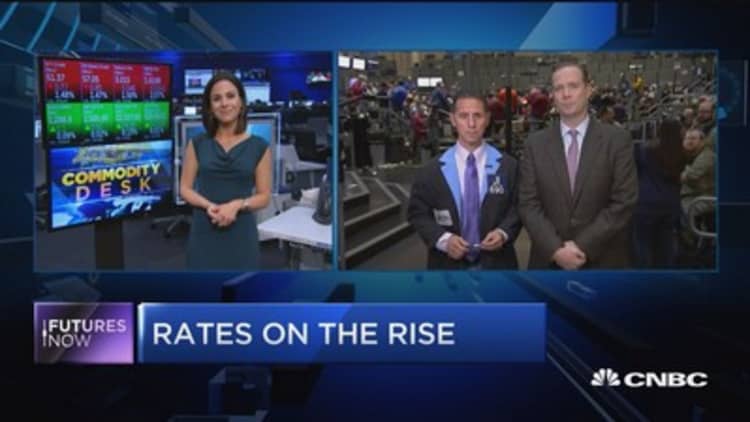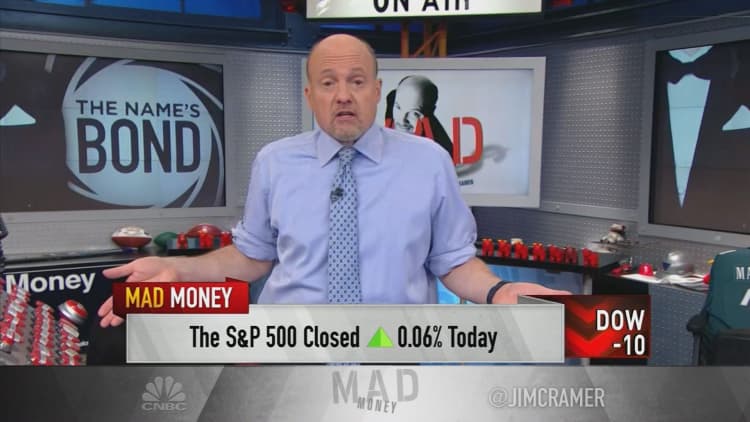
The bond market may have come to an important turning point, which means the fourth quarter could be a time of higher interest rates.
Treasury yields, which move opposite price, found a few good reasons to move higher in the final days of the third quarter. The 10-year yield was at 2.33 percent on Friday, after hitting 2.35 percent Thursday, its highest level since July. The was at 1.47 percent Friday, off from Thursday's 1.49 percent, a fresh nine year high.
Strategists say there were three big factors at work.
One is that the Fed is on a tighter policy course, and the market now gives it better than 70 percent odds for a December rate hike. Fed Chair Janet Yellen reminded investors of that Tuesday when she reaffirmed the Fed's goal of normalizing rates and called the lack of inflation a 'mystery.'
The Fed, following its meeting Sept. 20, announced a program to reduce its balance sheet, a major tool it used for extraordinary policy easing, in a final step away from financial crisis era programs.
The second is that the Fed is not alone in moving away from extraordinary policy, and as U.S. Treasury yields rose this week, global yields went higher too. Other central banks are also leaning toward tightening, including the European Central Bank which is expected to announce in October that it will slow its own bond purchases.
Third, the Trump administration and Congressional leaders unveiled a tax plan that the market believes will result in a bigger deficit and more debt, two things that would push up interest rates.

"If you look at the rest of the world, there was a noticeable move in 5- and 10-year rates in the U.S., Europe, the U.K., even Japan and Canada," said Mark Cabana, head of U.S. short rate strategy at Bank of America Merrill Lynch. "We think this is likely a sort of a global reassessment of term premiums, just given the fact we may be turning the corner on global monetary policy accommodation, and in the U.S., we're talking about tax cuts, almost certainly financed by a period of additional deficits."
Cabana said the tax package that's been introduced would contribute to a greater deficit until growth picks up, and he said the bond market's turn will be confirmed once the House passes a budget, allowing it to move forward on taxes.
"The fact the move [in yields] was global in nature, means it probably has a lot more staying power," said Cabana.
Yields on the front end, meaning bonds with 2-year and durations, could be the most active and gain the most because they are more sensitive to Fed easing and the Fed's balance sheet reduction. But the 10-year should also move up, and strategists mostly expect it to end the year higher, but not sharply higher.
Cabana has a year-end target of 2.85 percent for the 10-year, and he expects it to stay in that range until at least the middle of next year.
Michael Schumacher, director, rate strategy at Wells Fargo, said he also sees rates firming into the end of the year. His target is 2.50 percent for the 10-year note, and he expects it to move up to 2.80 percent next year.
In addition to the other catalysts, Schumacher said the Fed's balance sheet program could be supportive of rates. "You have the Fed balance sheet and we don't' know how that's going to to go. It seems to me wishful thinking to think it will be a nonevent," he said.
Another factor could be the fact that President Donald Trump is expected to appoint a new Fed chairman to replace Janet Yellen. Yellen is in the running but yields rose after a report Friday that Kevin Warsh, former Fed governor, was at the White House discussing the opening with the president and Treasury Secretary Steven Mncuhin.
Warsh is viewed as the leading candidate, but there are others under consideration including Fed Gov. Jerome Powell. Regardless of who is named, anyone other than Yellen will seem to the market to be a more hawkish choice. There is speculation that Warsh could drive the Fed to pare back its balance sheet even faster because he had voiced his opposition to quantitative easing, or the Fed's bond purchase program, when he resigned in 2011.
Aaron Kohli, director fixed income at BMO, does not expect rates to move higher into the year end, and his target is just barely higher, at 2.35 percent for the 10-year.
"It's going to be a rocky path at best. I do think rates are trending higher now for a variety of reasons. Warsh is a possible nominee, there's year end optimism, tax cut optimism. All these things do have an effect on yields, and it's generally higher," he said.
The 10-year yield started the year around 2.44 percent, hit a high of 2.60 in March and a low of 2.06 in September.
Of course, a geopolitical event or other factor could stir up buying in Treasurys, which drives rate s lower.
The 10-year could quickly drop below 2 percent, if there was any incident with North Korea, said Schumacher.
WATCH: Cramer's bull case for bonds in your portfolio



